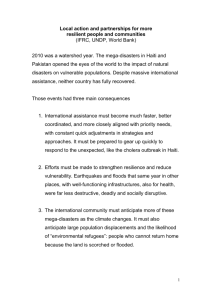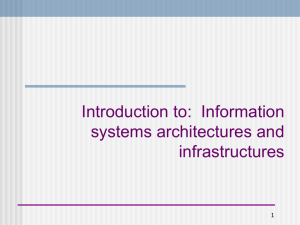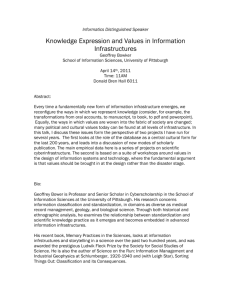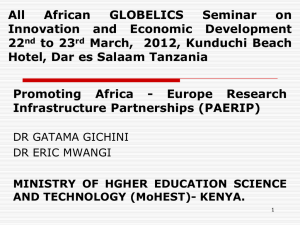+ European Research Infrastructures Framework Programme 7 FP7 2007 –2013
advertisement
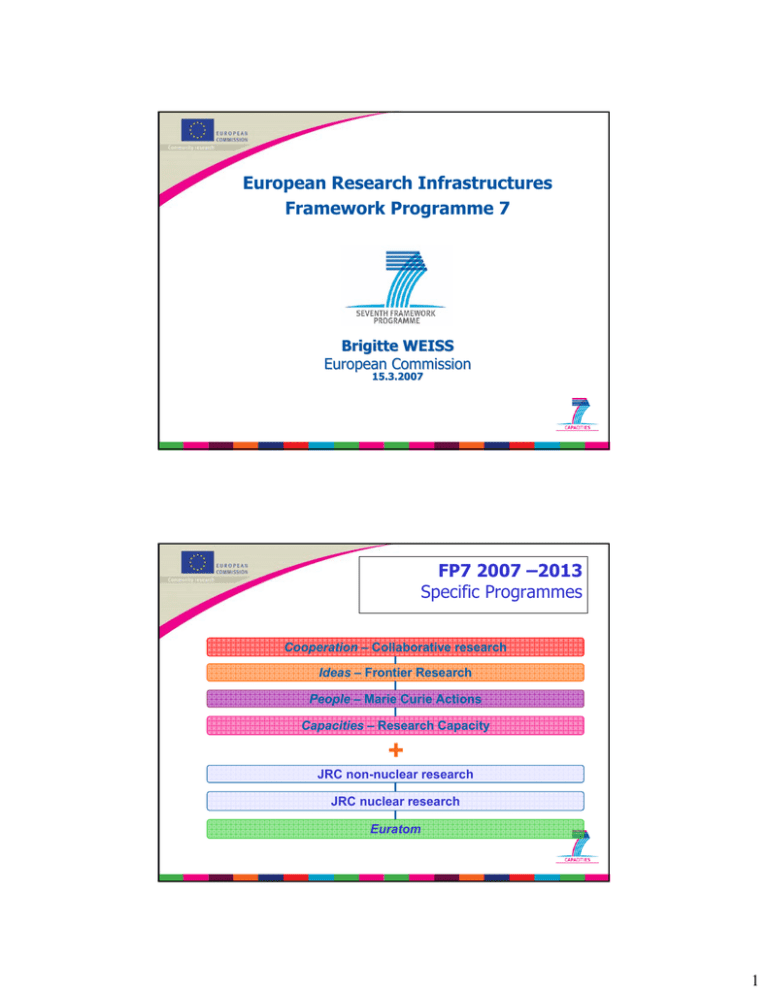
European Research Infrastructures Framework Programme 7 Brigitte WEISS European Commission 15.3.2007 FP7 2007 –2013 Specific Programmes Cooperation – Collaborative research Ideas – Frontier Research People – Marie Curie Actions Capacities – Research Capacity + JRC non-nuclear research JRC nuclear research Euratom 1 The Seventh Framework Programme: 2007 - 2013 JRC 1 751 Euratom Cooperation 4 062 32 413 Capacities 4 097 People 4 750 Ideas 7 510 FP7 budget (M€) Revised FP7 agreed by Council + Parliament in October 2006 FP7 versus FP6 z Significant increase of budget z Increase in duration z 4 Specific Programmes z European Research Council z Evolution, no revolution z Simplification 2 The Community Research Infrastructures action z “Research infrastructures” refers to facilities, resources and related services used by the scientific community for leading edge research ÎMajor scientific equipment ÎScientific collections, archives and structured information ÎEntities (of unique nature) used for research ÎICT-based infrastructures ÎCan be single-sited, distributed, virtual Objectives of the Community Research Infrastructures action z Optimising the use and development of the best existing research infrastructures in Europe (e.g. smart grids?) z Helping to create in all fields of S & T new research infrastructures of pan-European interest needed by the European scientific community z Supporting programme implementation and policy development (e.g. international cooperation) 3 The role of the Community Research Infrastructures action Member States Inclusion in national Programmes European Commission Stakeholders incl. EIROs Inclusion in Inclusion in Specific RTD DG REGIO / DG DEV Programme(s) strategic plans Projects EIB F RSF FP7 Research Infrastructures in brief Existing Infrastructures New Infrastructures Integrating activities Design studies e-infrastructures Construction (preparatory phase; construction phase) ESFRI Roadmap Policy Development and Programme Implementation 4 FP7 Support to existing Research Infrastructures z Integrating Activities to promote the coherent use and development of research infrastructures in a given field, implemented through: M€ ÎA bottom-up approach for proposals open to 580 013 all fields of science 7 2 200 ÎTargeted approach with topics defined in cooperation with the FP7 thematic areas z ICT based e-infrastructures in support of scientific research M€ 420 013 7-2 200 FP7 Support to new Research Infrastructures z Design studies: to support the conceptual design for new facilities or major upgrades, of clear European dimension and interest € 0M Îthrough bottom-up calls 7 013 7-2 0 0 2 z Support to the Construction of new infrastructures and major upgrades to existing ones ÎPreparatory phase ÎConstruction phase M€ 530 2013 7200 5 FP7 Support actions z A mixed bottom-up / top down approach, for: Îthe development of an RI European policy and the development of international cooperation ÎSupporting programme implementation (NCPs) and the coordination of research infrastructures in emerging areas zActivities: ÎERA-nets ÎConferences ÎStudies ÎNetworking of NCPs € 65 M 13 -20 2007 First call for proposals: new Research Infrastructures z For design studies, preparatory phase, and support actions Îdesign studies: 35 M€ ÎSupport actions: 28 M€ z Indicative budget for preparatory phase: Î34 projects z Closure: 2nd May 2007 z First contracts to come into force before end 2007 130 M€ 6 First call for proposals ctnd. z Design studies ÎDesign and feasibility of a new research infrastructure ÎTechnical work, organization, logistics,… z Preparatory phase: ÎCall limited to 34 projects on ESFRI list (member states commitment) ÎWork comprises all activities that lead to a start of the construction at the end of the PP-project ÎProjects have often been design studies in FP6 z At least 3 member states or associated states What is ESFRI? z The European Strategy Forum on Research Infrastructures z Brings together representatives of EU Member States, Associated States, and EC z To discuss the long term vision at European level and to support the development of a European RI policy ÎOpen method of coordination 7 The ESFRI Roadmap z Addressing 7 fields of Research and major challenges z From about original 200 proposals, thirty five (35) projects have been identified through several review stages z The Roadmap is the result of two years of intensive work ÎAbout 1000 high-level experts were involved, from every MS and AS, from most fields and user communities The ESFRI Roadmap for Environment AURORA BOREALIS EURO-ARGO EMSO r P 7 ts c e oj IAGOS-ERI LIFEWATCH EUFAR ICOS 8 Second call for proposals for existing Research Infrastructures z Project type: Integrating Activity z Indicative budget of 275 M€ Î25 to 30 projects to be selected z Closure: spring 2008 z Single stage procedure for evaluation Îremote + panel evaluation z Results within 4 months after closure date z First contracts will come into force before the end of 2008 No competition within one field of science! Objectives of an Integrating Activity project Structure better and integrate, on a European scale, the way research infrastructures operate and develop, in a given class: ÎBy opening and optimising the access to and the use of the existing research infrastructures in the different Member States and Associated States ÎBy better structuring and integrating, on a European scale, the operation(s) of research infrastructures, and by fostering their joint development (qualitative and quantitative) 9 Main characteristics of an Integrating Activity z Collaboration of existing research infrastructures in a given field of science ÎIdeally all major RI’s in Europe in one field ÎAt least 3 member states or associated states z 3 types of activities obligatory in one project ÎNetworking Activities ÎTrans-national Access ÎJoint Research Activities z Project type: combination of collaborative project + coordination and support actions An average Integrating Activity in FP 6 z Average number of contractors: 19 of which 7 are offering access (in FP6) z Typical duration of 4 years z Average EC contribution: ~10 M€ ÎManagement: ~ 6% ÎNetworking Activities: ~ 15% ÎTrans-national Access: ~ 36% ÎJoint Research Activities: ~ 43% z List of funded projects (FP6) http://cordis.europa.eu/infrastructures/projects.htm 10 Example: IA-SFS (Physics) developing a pan-European Synchrotron and FEL infrastructure EC contribution: 27 M€ TA (~19 M€): • 15 installations, with 4000 users from a very broad spectrum of disciplines NA (~2 M€): • Specialized workshops, conferences and schools (support areas of transnational cooperation) • Exchange of scientists e-infrastructures JRA (~6 M€): • European platform for Protein Crystallography • Development of: • Photo-injector for X-ray Free Electron Lasers • Instrumentation for Femto-second Pulses • Diffractive x-ray optics • Superconducting Ondulator Example: EUSAAR (Environment) EC contribution: 5.1 M€ Developing a pan-European research infrastructure for the measurements of atmospheric properties TA (~0.2 M€): 11 ground-based stations for atmospheric research NA (~3.2 M€): • Standards and exchange of good practices on sampling, measurement and analysis of aerosol parameters • Training on aerosol sampling and measurements • Web portal and Database on aerosol products JRA (1.7 M€): • Methodology for determining aerosol optical density • Standard procedures for aerosol hygroscopic growth determination • A real time data collection of aerosol measurements ¾A network of research stations exploiting the diversity of regional backgrounds 11 Example: EUPRIM-Net (Biomedical Sciences) EC contribution: ~4.7 M€ Developing a pan-European research infrastructure of primate centres TA (~1.3 M€): • Gene, tissue, cell, gamete and serum banks • Experimental animals NA (~1.7 M€): • Standards (SOPs for quarantine and experiments) • Training on handling (blood sampling, injections…) • Courses and textbook (primate behaviour, husbandry, nutrition…) JRA (~1.7 M€): • Molecular typing methods • Pathogen detection assays • Telemetry prototyping ¾Refinement, Reduction, Replacement Integrating Activities in FP7 z Bottom up approach for all fields of science (as in FP6) z New: targeted approach with topics defined in a priority setting process ÎTopics are complementary to R&D topics under the Cooperation Programme Îto help develop research infrastructures for European R&D needs ÎTo create synergies and ensure consistency with the Cooperation Programme ÎTo stimulate RI actions in specific fields that are currently not well covered 12 Priority topics for RI’s under the targeted approach z z z z z z z z Health (6) Food, Agriculture and Biotechnology (4) Information and Communication Technologies (3) Nanosciences, Nanotechnologies and Materials (2) Energy (5) Environment (4) Transport (2) Socioeconomic Sciences and Humanities (4) Î 30 priority topics for RI’s in 8 fields of R&D Priority topics for RI’s under the targeted approach z Example Environment: To bring together existing research infrastructures z European e-infrastructure on earth system’s understanding and modeling z For seismic engineering research and testing infrastructures z For establishing an efficient network on hydrological observatories,…, for water resources research z Integrating, for efficient polar research, existing observatories and monitoring stations … 13 Priority topics for RI’s under the targeted approach z Example Energy: To bring together existing research infrastructures z Aiming at the development of next generation biofuels z Integrating European testing and analysis RI for hydrogen and fuel cells z For ocean energy research z For concentrating solar power research z For research on Smart Energy networks Synergies Cooperation Programme and targeted RI activities: one Example z Priority topic for RI: To bring together existing research infrastructures for research on Smart Energy networks z Link with the Cooperation programme: Smart Energy networks, Activity Energy 2007.7 .1 – 7.3 z Typical existing RI relevant to the topic: EdF, France; ISET Test and certification Centre for Modular System Technology, D; CEA/CENEC/LSEC Laboratory for storage technologies, FR; T&D Consulting / High Power and high voltage laboratories, NL; Arsenal Research, Austria;… 14 1. Research Infrastructures Planning of calls and indicative budget Total operational budget 1665 M€ Call 1 Call 2 2007 2007 Integrating activities Call 3 2008 Call 4 2008 270 x x x x 42 Design studies 35 x 130 x Construction – Support to the Impl. Phase 113 Call 6 2012 e-Infrastructures Construction – Support to the Prep. Phase 50 Call 5 2010 RSFF (200 M€) + 130 M€ Policy Development and Programme Impl. 14 14 5 Total per call (M€) 221 64 275 x x 113 … in summary, an improved FP7 action for Research Infrastructures z An increased budget for FP7 (+30%) z Better consistency within FP7 (targeted calls) z Tackling better fragmentation (Integrating Activities) z Catalysing effect towards the construction or major upgrade of Research Infrastructures z A vision for the next 10-20 years fostering capacity building and excellence 15 Thank you for your attention For more information see http://cordis.europa.eu/fp7 16


